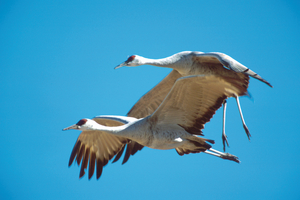For a few weeks each spring, one of the world’s most awesome wildlife spectacles occurs right here in Nebraska. Nearly half a million sandhill cranes descend upon the Platte River Valley to feed and rest before continuing their long northward migration to their breeding grounds in the northern United States, Canada and, for some, even Siberia. This is estimated to be approximately 80% of the world’s population of lesser sandhill cranes.
Typically, a few will arrive in mid-February, with more and more arriving, peaking in mid-March, then tapering off into April. The sights and sounds of cranes gathering along the Platte are unique and unforgettable.
Today, crane habitat is found primarily along an eighty-mile stretch of the central Platte River and the wetlands to the south. The birds’ migration paths funnel through this area, resulting in the congregation of the large numbers of cranes before they again spread out on their journey north. This was not always the case. Westward-traveling pioneers described the Platte as ‘a mile wide and a foot deep.’ Wet meadows and marshes, the ideal habitat for sandhill cranes, were found along much of the river. Cranes used many miles of the Platte for their migration stopover before the river was dammed for flood control and irrigation. Sediment collecting behind the dams, woody vegetation encroaching on the channel and reduced water flow have significantly decreased the area suitable for use by migrating cranes.
This spring, as they have for thousands of years before, the sandhill cranes will return to the Platte. They will share this migration oasis with endangered whooping cranes and many species of waterfowl, also migrating northward. People from all over the world will come to experience this spectacular event that occurs nowhere else on the planet – only in Nebraska.

